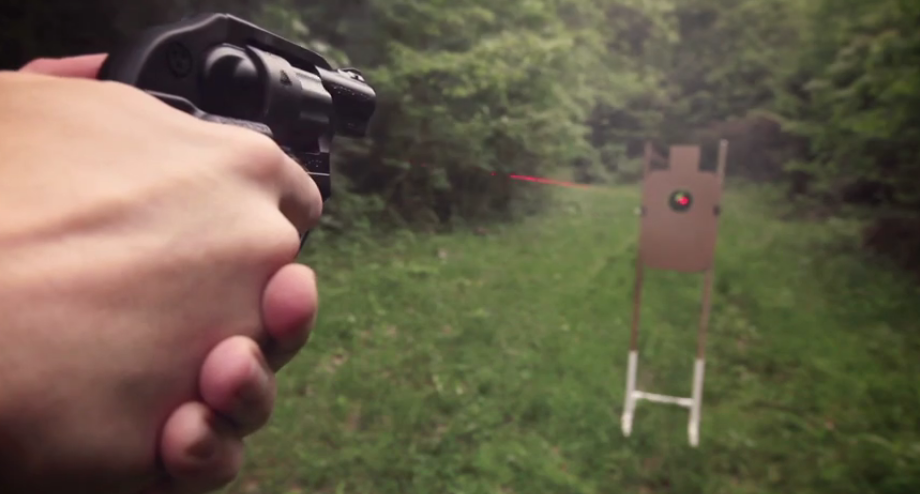Best .22 Magnum Pocket Pistols [2023]
For Personal Defense, Would You Carry one?

Having a reliable pistol that you’re comfortable with is ideal for pocket carrying. If you’re a newbie and want to start with a reliable pistol while working on your skillsets before going onto a higher caliber. Why not start with a .22 cal snub nose?
Before we get into the nittty gritty of pocket carrying a .22 caliber pistol. Here’s the quick list of some of the best .22 caliber pocket pistols that shoots the LR and WMR.
- Ruger LCR 22

The Ruger LCR line of revolvers is one of the most modern revolvers on the market. Ruger makes heavy use of polymer in the construction of their revolvers. This reduces the weight of a revolver and more affordable than using materials like Scandium. This Ruger LCR is a snub nose which has an enclosed hammer that makes the revolver easier to draw.
The Ruger LCR series is an excellent everyday option for someone looking for a small, but low recoil pocket pistol. The LCR weighs in at 14.9 ounces and is superbly small. This makes carrying the weapon very easy and very comfortable.
The LCR in 22LR holds 8 rounds, giving the user a good capacity for a revolver. The LCR 22 Magnum houses 6 rounds, which is one more than most snubbie revolvers. This increased capacity gives the user more shots and allows more forgiveness if a round fails to ignite.
The Ruger LCR line of revolvers has one of the best triggers out there. While the trigger pull is as long as a traditional DAO revolver, the pull is much lighter than a standard rimfire revolver. If a shooter has reduced hand strength and needs a 22 caliber round then they probably don’t have the strength for a heavy DAO trigger.
Even though the Ruger LCR is light and small there is almost zero recoil in both 22 LR and 22 Magnum. The 22 LR version has about as much recoil as a squirt gun. The 22 Magnum version has just a little more recoil, but it’s pleasant and tame.
If you’re into red laser, you can attach a Crimson Trace Laser grips. You can also attach a laser unit to the frame with the LaserMax device. - Smith & Wesson 43 C

This snubby at first glance can pass as a .38 Special, which is probably why its overlooked by plinkers. Consider a lightweight double-action revolver, weighing in at 12.3 ounces fully loaded with 8 rounds. This snubby comes with XS white dot front sight and a large U-shaped notch for the rear sight. Which really helps picking up the flash sight picture quickly.
The trigger break is not smooth pulling at 12 pounds which is common for j-frames. (stiff double action trigger) For some that have shot this are saying, “Its a hoot to shoot!” - Beretta 21A Bobcat

A semi-auto .22 pocket pistol size from Beretta. The pistol has a tip-up barrel that lets you chamber without racking the slide. Has a manual safety and a mag release on the left side of the grip. This gun has a very small sight and is a double action/single trigger. Weighs in at 16 ounces, smaller than a Ruger LCR and holds 8 rounds.
Clearing a malfunction in this Bobcat can be a pain. - Taurus PT-22

Another truly pocket size semi-auto pistol. This Taurus PT22 is very small and lightweight, easy to shoot, and has very little to no recoil. Similar to the Beretta Bobcat 21, the barrel tips up to load/unload the first, chambered round. There are no advantages to carrying this but a really nice gun for a newbie to learn to shoot with. - NAA LLR Revolver

NAA revolvers are excellent pocket guns that can go anywhere you couldn’t normally use a larger gun. The price is easy to justify for the level of quality, especially in the fit and finish.
The gun may seem slightly unsafe with the spur trigger, but the gun is surprisingly innovative on the safety aspects. The hammer can rest on a full chamber safely, due to the hammer lock and the small footprint and simple operation allows you to always be prepared. This is an excellent small backup gun for self-defense.
With all that said, and if you’re still seriously want to carry this, you would need to practice with it. Shooting this NAA revolver takes some time getting used to, especially while under stress. - Trailblazer LifeCard .22 LR

The LifeCard is small. Smaller than a deck of playing cards. The LifeCard is 1/2-inch thick and is 3.375 inches long when it’s closed, around 4 inches when open.
The LifeCard is a single shot .22 and has storage for 4 more rounds of .22LR in the grip. To reload, you need to tip the barrel, load a round, then manually cock the hammer. Think of it loading like the classic side-by-side double-barrel shotguns. On the practical side of things, we’re not sure if this is worth having. Yes, the LifeGuard hands down is the ultimate James Bond concealed backup gun.
For the rest of this article we look at the different .22LR and WRM loads that were tested against the ballistics gel with these smaller pocket pistol.
If you know of a truly decent pocket size pistol please let us know.

Ballistics
Prices on the .22 LR and WMR are really affordable, even the premium ones. The first two are ballistic gel test results were collected from Lucky Gunner Labs. These were sorted to view from the short barrel results.
.22LR

From this testing we see the Winchester 37 gr Varmint HE 3 average 5-shot depth is 12.7 inches of penetration.
The CCI 40 gr Velocitor CPHP 3 average 5-shot depth was at 13.1 inches.
22WMR

These magnums penetrations were much better than the LR. The best came from CCI 40 gr Maxi-Mag JHP 5-shot average depth at 15.8 inches. The next best was Fiocchi 40 gr Performance JSP was at 15.1 inches.
This chart below on .22 WMR gives you another set of numbers from different brand ammo – its just to see where the numbers fall into place from two different sources.

Its still Manly to Carry a .22 Caliber Pocket Pistol
For the intermediate to advanced shooters, we’re not saying to drop your 45’s and convert over to .22s. For some of us that are budget challenged and some how the .22 caliber just fits the bill for personal defense and survival. (preppers)
Our pick almost hands down is the snubby from Ruger and/or S&W 43C for reliability over the semi-auto pocket pistols. And, the extreme joy of shooting.
Personal Defense
Some may argue that the .22 WMR is too small for personal defense. Those that think this way are looking at it from a hunter mindset, that is one shot one kill.
However, for self-defense purpose the primary objective is stop the bad guy from doing bad things.
There are three ways to stop a threat with a pistol:
- Causing enough pain that the bad guy submits or voluntarily decides to stop
- Incapacitation, which is an involuntary reaction on the part of the bad guy in response to being shot, this can be instant or it can take some time.
- Using Fear as a psychological deterrent, no one wants to get shot at when there is gun pointed at them.
Let’s move onto the cartridge itself, yes, its not a .357.
The .22 WMR does not have the stopping power of a .357, it does have velocity. Back to this later, many gun experts will test out these cartridges against a gel. Its simply a ballistic test medium which is thought to offer the same resistance to a bullet as would muscle tissue.
However, it does not replicate skin, ribs, cartilage or fat and, in fact, very often the way a bullet performs in living tissue is quite different than how it performs in gelatin.
Ok, you’re still stuck on the different calibers and how a .22 compares.
Caliber Comparisons
Here an interesting comparison that pitted the .22 WRM, 9mm and a .45 ACP. The penetration from the heavier slugs was deeper at 13 inches. The .22 WRM was going in at a little over 12 inches. One inch differences.
Velocity
The average 9mm Luger velocity ran about 1,175 fps.
The average .45 ACP ran at 1000 fps.
The .22 WMR fps came in at 1,050 fps.
Again not much differences
Terminal Performances
When looking at terminal performances its about expansion but on a short barrel we’re not going to see this. Unless, its from a higher caliber or from a longer barrel.
Expansion is important because if you have two holes that are the same depth, the hole that has the largest diameter will also be the one that is likely to do the most tissue damage.
Penetration is the length of the bullet path after entering soft tissue, in this case we see it in the ballistic gel. The goal is to see the depth at 12 inches, according to the FBI standard. (image below)
The average frontal diameter of the .22 WMR bullets is about 0.27 inches.
The 9mm Luger was at 0.55 inches.
The .45 ACP came at 0.61 inches.
The damage is translated into cubic inches of tissue.
9mm Luger = 3 cubic inches
.45 ACP = 3.79 inches
.22 WMR = 1 inch
If you’re a statistical person and just going by terminal performances, obviously you wouldn’t pick the .22 WMR as a choice to carry.
What’s misleading in the world of self-defense is that people seem to think the one shot that incapacitates normally doesn’t happen. True that the .22 WMR does not bring instant incapacitation.
But for deterrent and quick shooting a .22 WMR can still be effective to put some pain on a bad guy to get them to stop so you can run away to get help.

Sources: Featured image, Video and chart from Lucky Gunner




